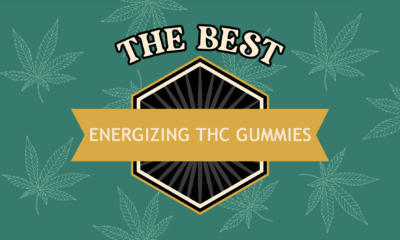addiction
3 Myths About Cannabis Use Disorder – Cannabis | Weed | Marijuana
Published
2 years agoon
By
admin
What are three myths about cannabis use disorder? Arguably, the entire concept is a myth. Regardless, the US has an ICD-10 code for cannabis disorder. As well as a cannabis ICD 20 code. Although none of these accurately describes the myth.
For that, we turn to the DSM-5’s definition of cannabis use disorder. They list twelve points that suggest chronic cannabis use or daily cannabis use is considered a “disorder.”
Some of these cannabis use disorder symptoms include:
- A persistent desire or unsuccessful efforts to cut down or control cannabis use.
- Craving, or a strong desire or urge to use cannabis.
- Experiencing cannabis withdrawal
There’s more, but the common thread is involuntary behaviour. Cannabis use disorder, or any addiction, is characterized by this belief that we’re not choosing to consume but are compelled to and can’t stop.
Now, we’re not denying that some people feel this way. Maybe you wish you could cut back to weekends only, but the thought of moderating cannabis is too daunting. Laughable, really.
Unfortunately, politicians and public health busybodies are no help. Rehabilitation and treatment centers often do more harm than good.
And while three myths about cannabis disorder may not seem like a huge deal, when it comes to the opioid crisis, these myths are killing people.
For we can apply these three myths of cannabis use disorder to any drug that produces a high. We do not deny that you may feel compelled to use substances despite adverse consequences. But by exposing these three myths, you can cut through public health BS and decide for yourself.
Cannabis Use Disorder Myth #1: Loss of Control
Addiction and recovery ideology is a lot like banking. When you go to the bank, you’re not depositing your money. You’re loaning it to the bank.
Most people have no idea what fractional reserve banking is. If they understood how the Federal Reserve’s “open market operations” have led to massive inflation, we’d have a revolution by tomorrow morning.
Or take modern race relations. Martin Luther King’s belief that we’d treat each other as individuals has been turned upside down. Now we’re members of an identity group first and individuals second (if at all).
But race is a social construct. Biologically speaking, we’re all homo sapiens. Our skin color is determined by how close our ancestors were to the equator.
Likewise, addiction is a social construct. “Addiction experts” speak of a loss of control regarding drug use. The idea is once you pop, the fun can’t stop.
If you smoke one joint, then you’ll gonna have two. And why the hell not? Make it three.
Perhaps this myth of cannabis use disorder needs no debunking. But almost everyone believes that a former problem drinker can never drink again. And likewise, how many former cannabis consumers are afraid to touch the herb less they become “re-addicted?”
Of course, several laboratory experiments have never found proof of this myth. Even hardcore opioid addicts will reduce or save doses when the supply is low. Being able to economize your drugs is not part of the “disorder” paradigm.
The fact is: there is no loss of control because people are making choices to use substances based on their internal (and subjective) value scales.
Cannabis Use Disorder Myth #2: Hijacking the Brain
Another myth of cannabis use disorder is that cravings or a “desire to use” cannabis happens outside you. As if it were an external force compelling you to behave.
We’ve covered this topic before. There is no “hijacking” of the brain. Even drugs like cocaine that alter the mesolimbic pathway aren’t inherently “addictive.”
Eating increases dopamine. Food alters the mesolimbic pathway — especially high-fat diets. Maybe next, we’ll hear about “Keto Diet Disorder” in an attempt for public health to further demonize red meat and salt.
But don’t take our word for it. Here’s the conclusion of one scientific researcher:
There are no published studies that establish a causal link between drug-induced neural adaptions and compulsive drug use or even a correlation between drug-induced neural changes and an increase in preference for an addictive drug.
The brain disease model of addiction is completely bunk. Like the last of the nutritionists holding onto the “low-fat processed food is good you” trend, the researchers supporting the brain-disease model are a dying breed. The facts do not support their ideology.
The brain changes that “cause” addiction occurs when you form habits. No one feels compelled to play the guitar. But if you practice long enough, the neural changes will make chord progressions and soloing much easier.
Cannabis Use Disorder Myth #3: Cannabis Withdrawal
What is considered heavy cannabis use? Apparently, experiencing withdrawals. According to the DSM-5,
Withdrawal, as manifested by either (1) the characteristic withdrawal syndrome for cannabis or (2) cannabis is taken to relieve or avoid withdrawal symptoms.
It does not follow that experiencing withdrawal means you have “cannabis use disorder.”
Throughout history, withdrawals have been considered a sickness in response to your body excreting the drug. That is, technically, all that a withdrawal is.
An alcohol hangover is a withdrawal of ethanol. Suppose you go on a one-time bender and experience the consequences the following day. Are you, therefore, now an alcoholic? Will you be compelled to drink more to starve off the hangover?
You don’t even have to show withdrawal symptoms to feel addicted. What are the withdrawals from problematic gambling or sex? Boredom?
Almost everyone drinks coffee in the morning to avoid caffeine withdrawal. Do we have caffeine use disorder?
But What About the Pleasure Spots in the Brain?
These three myths of cannabis use disorder aren’t myths at all, we hear some of you say. Drugs aren’t like food; drugs hit the pleasure spot (or reward circuit) in the brain. That’s why you get addicted.
According to the critic, cannabis use disorder may be milder compared to opioid use disorder, but it’s a serious disease nevertheless.
But pleasure is subjective. Consider an activity that hits the brain’s pleasure spots: listening to music.
Researchers have recorded brain scans of people listening to music. They concluded,
We have shown here that music recruits neural systems of reward and emotion similar to those known to respond specifically to biologically relevant stimuli, such as food and sex, and those that are artificially activated by drugs of abuse. This is quite remarkable, because music is neither strictly necessary for biological survival or reproduction, nor is it a pharmacological substance.
Music consists of sound waves travelling through the air. Nothing is going into your body. Yet, who hasn’t had moments of intense pleasure and reward from listening to their favourite song?
Cannabis use disorder symptoms are based on ideology, not science.
Suppose you see yourself in some of the DSM-5’s definitions of cannabis use disorder. You’d be better off reading our previous posts on this subject than paying big bucks to a psychiatrist who will misdiagnose you.
Cannabis use disorder is a myth. Like all addiction and treatment ideology, it’s a social construct. It exists only in people’s minds. It has no basis in objective reality.
addiction
Can Psychedelics Treat Addiction and Alcoholism?
Published
7 months agoon
September 13, 2024By
admin
Psychedelics, once associated primarily with counterculture and recreational drug use, are now being seriously studied for their therapeutic potential in treating drug addiction and alcoholism. Recent research has shown that substances like psilocybin, LSD, and ayahuasca may have profound benefits for individuals struggling with Alcohol Use Disorder (AUD) and substance use disorders (SUD). These compounds are being reconsidered not only for their ability to induce altered states of consciousness but also for their potential to address addictive behaviors and psychological trauma at the root of addiction.
Psilocybin’s Efficacy in Treating Alcohol Use Disorder
One groundbreaking study, conducted at New York University and Johns Hopkins University, demonstrated the potential of psilocybin in treating Alcohol Use Disorder (AUD). The researchers focused on individuals with severe AUD, administering two doses of psilocybin in conjunction with psychotherapy. The results were notable: participants reported a 50% reduction in heavy drinking days over an eight-month period, with some maintaining abstinence from alcohol even a year later.
The trial followed a double-blind, randomized approach and found that the therapeutic effects of psilocybin were superior to those observed with placebo treatments. Dr. Michael Bogenschutz, a lead researcher in the study, emphasized the importance of the psychedelic experience itself in breaking the cycle of addiction. Psilocybin appears to help patients break through entrenched mental patterns, often revealing deeper emotional connections and realizations that drive more meaningful behavior change.
How Psychedelics Influence the Brain to Combat Addiction
The mechanism behind the efficacy of psychedelics in treating addiction is thought to involve neuroplasticity, or the brain’s ability to reorganize and form new connections. By interacting with serotonin 2A receptors, particularly in the prefrontal cortex and default mode network, psychedelics can enable profound shifts in perception and cognition. These altered states of consciousness allow individuals to confront underlying psychological issues, such as trauma or negative emotional patterns, which are often at the core of addictive behaviors.
Many individuals undergoing psychedelic-assisted therapy report experiencing a “reset” of their mental state, facilitating a more open mindset that helps them engage with therapy in a deeper, more effective way. This contrasts with traditional addiction treatments, such as methadone or buprenorphine, which primarily manage withdrawal symptoms but do not address the psychological components of addiction.
LSD and Its Potential in Addiction Treatment
LSD (lysergic acid diethylamide) has also shown promise in treating addiction, particularly alcoholism. Early studies from the 1950s to the 1970s suggested that LSD might help reduce alcohol dependency, but interest in this line of research waned due to regulatory crackdowns on psychedelic research. However, more recent studies have reignited interest in LSD’s therapeutic potential.
A meta-analysis published in the Journal of Psychopharmacology reviewed data from six trials involving over 500 patients. It concluded that a single high dose of LSD, administered in a therapeutic setting, was associated with a significant reduction in alcohol consumption. The study found that LSD’s psychedelic effects could lead to lasting changes in personality traits, such as openness and emotional resilience, which are crucial for overcoming addiction.
Ayahuasca and Addiction Recovery
Ayahuasca, a traditional Amazonian brew containing DMT (dimethyltryptamine) and MAO inhibitors, has been the focus of recent studies examining its potential to treat addiction. Researchers have found that ayahuasca’s intense psychoactive properties, combined with its ability to facilitate introspection and emotional healing, may help individuals overcome opioid and stimulant addiction. A study published in Frontiers in Pharmacology noted that ayahuasca led to significant improvements in mental health and reductions in addictive behaviors.
Ayahuasca ceremonies, often conducted in a spiritual context, have been shown to promote healing through vivid and sometimes challenging visions. Participants often report gaining insights into the underlying causes of their addiction, leading to long-lasting psychological benefits.
Challenges in Psychedelic-Assisted Therapy
While the results of these studies are promising, the use of psychedelics in treating addiction is not without challenges. For one, the psychedelic experience itself can be unpredictable, and not all patients experience the profound mystical or emotional breakthroughs associated with positive outcomes. The effectiveness of psychedelic-assisted therapy appears to be linked to the quality of the therapeutic environment and the expertise of the facilitators, meaning that careful preparation and integration are key to success.
Moreover, while psychedelics like psilocybin and LSD do not appear to be physically addictive, their use must still be carefully regulated to prevent potential psychological risks, such as hallucinations, anxiety, or psychotic episodes in vulnerable individuals. Current research emphasizes the need for controlled settings where trained therapists can guide patients through their psychedelic experiences.
Ongoing Research and Future Directions
Given the promising early results, psychedelic research is entering a new phase, with larger clinical trials currently underway. The National Institutes of Health (NIH) recently allocated $2.4 million to explore the use of psychedelics in treating methamphetamine addiction, further solidifying the role of psychedelics in addiction therapy. Similarly, ongoing studies are looking into psilocybin’s potential to treat opioid addiction and cocaine dependence, conditions that have been notoriously difficult to treat with conventional methods.
As research progresses, it is likely that psilocybin, LSD, and other psychedelics will become more widely recognized as effective tools for addiction treatment. While more research is needed to fine-tune these therapies and better understand their long-term effects, early indications are that psychedelics could revolutionize addiction and alcoholism treatments in the coming decades.
Conclusion
Psychedelics like psilocybin, LSD, and ayahuasca are emerging as potential breakthrough therapies for treating drug addiction and alcoholism. By promoting neuroplasticity and addressing the psychological roots of addiction, these substances offer an alternative to traditional addiction treatments, which often focus on managing symptoms rather than curing the disease. With ongoing research and increasing clinical trials, psychedelic-assisted therapy may become an essential tool in the fight against substance use disorders, offering hope to millions of people who struggle with addiction, such as alcoholism.
Sources
Johns Hopkins Medicine: Psychedelics in Addiction Treatment
Progress in Neuro-Psychopharmacology and Biological Psychiatry
National Institutes of Health (NIH) Research on Psychedelics
Frontiers in Pharmacology: Ayahuasca for Addiction Recovery
JAMA Otolaryngology – Head & Neck Surgery
Related
addiction
The Evolving Opioid Crisis in Europe: Heroin and Synthetic Threats
Published
7 months agoon
September 12, 2024By
admin
The opioid crisis in Europe is growing in complexity, with heroin continuing to dominate the market while synthetic opioids, such as fentanyl and its analogs, emerge as potent new threats. The 2024 EU Drug Markets Report, released by the European Monitoring Centre for Drugs and Drug Addiction (EMCDDA) and Europol, provides a comprehensive analysis of the heroin and synthetic opioid market, detailing the health risks, evolving trafficking routes, and potential future challenges.
Heroin in Decline? Why Synthetic Opioids Pose a New Threat in Europe
Heroin’s Ongoing Impact in Europe
Heroin remains the most commonly used illicit opioid in Europe, with an estimated 1 million high-risk opioid users. The European heroin market is valued at over €5.2 billion annually, indicating the persistent demand for this drug. In 2021, EU countries seized 9.5 tonnes of heroin, the largest quantity in 20 years. These figures underscore the strong presence of heroin in Europe, despite the introduction of harm reduction programs aimed at curbing opioid use.
The health consequences of heroin use are severe. In 2021, opioids were responsible for three-quarters of Europe’s 6,000 drug-related overdose deaths, with heroin being a leading factor. Long-term users are aging, adding complexity to public health strategies, as older opioid users present with more chronic health problems.
Afghanistan’s Opium Ban: Future Implications for Heroin Supply
Nearly all heroin consumed in Europe is derived from opium produced in Afghanistan. However, Afghanistan’s opium production has seen a dramatic decline following the Taliban’s 2022 ban on poppy cultivation, which led to a 95% reduction in production by 2023. While the immediate impact on heroin availability in Europe has been minimal, the report warns that a sustained ban could lead to future heroin shortages. Such shortages could open the door for synthetic opioids to dominate the market.
The decline in Afghan opium cultivation from 233,000 hectares in 2022 to just 10,800 hectares in 2023 has raised concerns about the future of heroin availability in Europe. Should the Taliban continue to enforce the ban, experts believe the resulting heroin scarcity could increase the use of more potent and dangerous synthetic opioids, exacerbating the public health crisis.
The Rise of Synthetic Opioids: Fentanyl and its Analogues
Synthetic opioids, such as fentanyl, are becoming more prevalent in the European drug market. These substances are far more potent than heroin, and even small doses can lead to fatal overdoses. The 2024 report highlights how these synthetic opioids are contributing to a growing number of overdose deaths and hospital emergencies across Europe. In countries such as Estonia and Sweden, fentanyl is responsible for a significant proportion of drug-related deaths.
Fentanyl analogs are particularly concerning because they can be mixed with other drugs like heroin or cocaine, often without the user’s knowledge. The increasing presence of these synthetic opioids is a major public health concern, as traditional harm reduction measures, such as naloxone distribution and needle exchange programs, are less effective against these more potent substances.
Changing Trafficking Routes and Criminal Networks
Traffickers are increasingly adapting their methods in response to heightened enforcement measures and geopolitical developments. The traditional Balkan route, which brings heroin through Turkey and Bulgaria into Europe, has seen increased enforcement and stricter border controls, prompting traffickers to shift towards alternative routes.
The Southern route is becoming more prominent, with significant heroin shipments passing through Iran and Pakistan before reaching Europe via major seaports. The United Arab Emirates (UAE) has emerged as a key transshipment hub for heroin, providing both logistical support and avenues for money laundering. Meanwhile, the ongoing Russia-Ukraine war has prompted criminal networks to modify their trafficking routes, further complicating law enforcement efforts.
Public Health and Harm Reduction Efforts
Harm reduction strategies have had some success in mitigating the impact of opioid use in Europe. Programs such as opioid substitution therapy (OST) and needle exchange have helped reduce the number of new users injecting heroin, thereby lowering the risks of HIV and hepatitis C transmission. However, the growing prevalence of synthetic opioids poses new challenges. These potent drugs often require stronger overdose prevention measures, such as fentanyl test strips and more widespread access to naloxone, an opioid antagonist used to reverse overdoses.
Additionally, the report notes the importance of expanding data collection and improving early warning systems to monitor emerging trends in opioid use and trafficking. These systems allow public health authorities and law enforcement to respond more quickly to new synthetic opioids entering the market.
Challenges in Treating Opioid Addiction
Treatment for opioid addiction, particularly heroin, is evolving. Europe’s aging population of opioid users presents new challenges, as older users are more likely to have complex medical conditions. Many long-term users require not just drug treatment but also social support and healthcare for chronic conditions related to long-term substance use. Furthermore, gender-specific issues are emerging, as women who use opioids face more barriers to accessing treatment and are more likely to present with co-occurring psychological or social issues.
Conclusion
The opioid crisis in Europe is evolving, with heroin still posing a significant threat to public health, while synthetic opioids like fentanyl are emerging as an even more dangerous force. The reduction in Afghan opium production and the shifting trafficking routes complicate the landscape further. To tackle this complex issue, Europe must continue to invest in harm reduction, international cooperation, and early warning systems to prevent more overdose deaths and manage the changing face of the opioid market. Without a coordinated response, Europe risks facing an even more devastating public health crisis in the coming years.
Related

The fact that some people are eating dogs and cats is a highly sensitive topic that crosses cultural, social, and ethical boundaries. In many regions, these animals are consumed due to cultural traditions and necessity, while in other cases, drug-induced behavior may lead individuals to engage in extreme or unusual dietary practices. This article aims to explore the distinction between cultural norms and the desperate, erratic behaviors driven by substance abuse, focusing on the need for cultural sensitivity while addressing harmful behavior.
When Culture Meets Addiction: Who Is Eating Dogs and Cats?
Cultural Practices and the Consumption of Non-Traditional Animals
In some parts of Asia and Africa, the phenomena of eating dogs and cats has historical roots that are tied to both cultural traditions and the availability of resources. In these regions, the eating of non-traditional animals is a normalized practice and is not connected to drug-fueled behavior.
- Cultural Normalcy: In regions such as South Korea, China, and Vietnam, dogs have historically been consumed as part of traditional cuisines. This practice is not driven by addiction or desperation but by cultural norms that view these animals as a food source rather than pets.
- Food Scarcity: In some communities, especially in impoverished or rural areas, consuming non-traditional animals like dogs or cats is a practical response to food scarcity. The decision to eat these animals is based on survival rather than personal preference or altered judgment.
Drug-Induced Dietary Choices: When Addiction Leads to Extreme Behaviors
In contrast to cultural practices, there are cases where individuals under the influence of drugs engage in extreme or bizarre behaviors, such as eating dogs and cats… This behavior is driven by impaired judgment, psychosis, or desperation caused by addiction, and often occurs in isolated or marginalized communities.
- Methamphetamine and Erratic Behavior: Meth users are known to exhibit extreme and irrational behaviors, including eating animals they wouldn’t normally consider food. Meth-induced psychosis can blur the lines between reality and hallucination, leading to bizarre dietary choices such as consuming pets or strays.
- Desperation from Heroin Addiction: Heroin addicts, especially those living in extreme poverty, may consume non-traditional animals out of necessity. Chronic malnutrition and impaired judgment, combined with isolation from society, can drive addicts to make choices they wouldn’t otherwise consider.
Understanding the Cultural vs. Drug-Fueled Divide
It’s crucial to differentiate between cultural practices and behaviors driven by addiction when discussing the consumption of non-traditional animals. Respecting cultural practices while addressing the harmful impacts of substance abuse requires a nuanced understanding of these different contexts.
- Cultural Sensitivity: When discussing the consumption of non-traditional animals, especially in regions where this practice is accepted, it is important to approach the subject with cultural sensitivity. Condemning these practices without understanding their historical and social context can perpetuate stereotypes and breed intolerance.
- Addressing Addiction-Related Behaviors: Conversely, when the consumption of animals like dogs and cats is tied to addiction, the focus should be on treating the root causes of drug abuse rather than criminalizing individuals. Rehabilitation, mental health support, and access to food resources are critical in preventing desperate behaviors.
Ethical Considerations and Animal Welfare
Regardless of whether the consumption of non-traditional animals is driven by culture or desperation, the ethical treatment of animals is a key concern. The dog and cat meat industries have come under scrutiny for their inhumane treatment of animals, and organizations worldwide are working to promote animal welfare and ethical eating practices.
- Animal Rights in Cultural Contexts: While respecting cultural traditions, animal rights organizations are increasingly advocating for more humane practices within these industries. Campaigns to ban or reduce the consumption of dog and cat meat have gained traction, with a focus on reducing cruelty and promoting alternative food sources.
- Animal Cruelty and Drug Addiction: In cases of drug-induced behaviors, the animals involved often suffer from neglect or harm. Providing support for addicts and ensuring animals are removed from harmful environments can help mitigate this issue.

How to Approach the Issue Globally
Addressing the issue of non-traditional animal consumption, whether cultural or drug-fueled, requires a global approach that balances respect for cultural practices with the promotion of humane treatment for animals. Public health initiatives and cultural sensitivity training can help bridge the gap between different viewpoints while ensuring that animals and people alike are treated with dignity.
- Promoting Cultural Understanding: Efforts to educate the public on the cultural contexts of eating non-traditional animals can help reduce prejudice and promote more respectful global dialogues. Cultural exchange programs and educational campaigns can provide a more nuanced view of these practices.
- Addressing Substance Abuse: On the other hand, combatting the desperation and irrational behavior caused by addiction requires investments in mental health, addiction treatment, and public welfare systems. Providing addicts with support, housing, and access to food can reduce the likelihood of harmful or extreme behaviors.
Conclusion
While the consumption of non-traditional animals like dogs and cats may be culturally accepted in some regions, drug-induced behaviors that lead to similar actions must be understood in a different light. It’s important to address addiction-related behavior with compassion, focusing on rehabilitation and support rather than punishment. At the same time, promoting animal welfare and humane practices in regions where these animals are consumed can create a more ethical global community. By approaching these issues with respect for cultural diversity and a commitment to reducing harm, both animals and humans can benefit.
Related

The best energizing THC gummies of 2025 by Leafly

Mixed Messages From The Feds About Cannabis

How Hemp Helps You Sleep

420 in Texas is at Reggie & Dro

Daily Cannabis Use Can Help People Get Off Opioids (STUDY)

This Wine Issue Is Becoming More Common

Get more for less this 420 at PurLife

Can You Order Cannabis through DoorDash?

Cannabis Enthusiast-Friendy Retreats – GanjaVacations Jamaica

The road ahead for cannabis lending in 2025

Distressed Cannabis Business Takeaways – Canna Law Blog™

United States: Alex Malyshev And Melinda Fellner Discuss The Intersection Of Tax And Cannabis In New Video Series – Part VI: Licensing (Video)

What you Need to Know

Drug Testing for Marijuana – The Joint Blog

NCIA Write About Their Equity Scholarship Program

It has been a wild news week – here’s how CBD and weed can help you relax

Cannabis, alcohol firm SNDL loses CA$372.4 million in 2022

A new April 20 cannabis contest includes a $40,000 purse

Your Go-To Source for Cannabis Logos and Designs

UArizona launches online cannabis compliance online course
Trending
-

 Cannabis News2 years ago
Cannabis News2 years agoDistressed Cannabis Business Takeaways – Canna Law Blog™
-

 One-Hit Wonders2 years ago
One-Hit Wonders2 years agoUnited States: Alex Malyshev And Melinda Fellner Discuss The Intersection Of Tax And Cannabis In New Video Series – Part VI: Licensing (Video)
-

 Cannabis 1012 years ago
Cannabis 1012 years agoWhat you Need to Know
-

 drug testing1 year ago
drug testing1 year agoDrug Testing for Marijuana – The Joint Blog
-

 Education2 years ago
Education2 years agoNCIA Write About Their Equity Scholarship Program
-

 Cannabis2 years ago
Cannabis2 years agoIt has been a wild news week – here’s how CBD and weed can help you relax
-

 Marijuana Business Daily2 years ago
Marijuana Business Daily2 years agoCannabis, alcohol firm SNDL loses CA$372.4 million in 2022
-

 California2 years ago
California2 years agoA new April 20 cannabis contest includes a $40,000 purse













